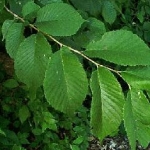| Common Name: |
Red Elm |
| Other Names: |
American Elm, Indian Elm, Moose Elm, Rock Elm, Slippery Elm, Sweet Elm, Winged Elm |
| Botanical Name: |
Ulmus rubra syn. U. fulva |
| Genus: |
Ulmus |
| Family: |
Ulmaceae |
| Native Location: |
S Canada to C America |
| Cultivation: |
Deep, moist soil in sun. Plants may be damaged by aphids, caterpillars, gall mites, fungal infections, and Dutch elm disease. |
| Propagation: |
By seed sown in autumn; by greenwood cuttings in summer; by removing rooted suckers in autumn; by grafting in winter. |
| Harvest: |
Inner bark is stripped from trunks and larger branches in spring, dried and powdered for use in decoctions, liquid extracts, ointments, poultices, powders, and tablets. Fine powder is used internally; coarse powder is used for poultices. |
| Height: |
20m (70ft) |
| Width: |
18m (60ft) |
| Hardiness: |
Z3-10 |
| History: |
One of the few herbs to receive a stamp of approval from the U.S. Food and Drug Administration (FDA), slippery elm, a native of North America, is an excellent demulcent that soothes and heals inflamed membranes in the throat, chest, intestines, stomach, and urinary tract. Slippery elm's bark was much used by Native Americans to treat coughs, congestion, skin infections, sore throats , and wounds. The first rudimentary throat lozenges and cough drops were often made with slippery elm. Native healers also mixed the powdered bark with a small amount of eater to make vaginal suppositories that were used to treat tumors and vaginitis. Early American settlers, who learned about the herb from their Native American neighbors, gave slippery elm a bad name for a while by using decoctions of the fresh bark to abort what one source calls "half-breed fetuses". This dark practice led to a widespread ban on using the fresh herb. The dried and powdered bark, however, which has no abortifacient properties, is widely available today. |
| Parts Used: |
Inner bark rind |
| Properties: |
A sweet, mucilaginous, laxative herb with a fenugreek-like odor. It soothes and lubricates tissues, draws out toxins, and promotes healing. |
| Medicinal Uses: |
Internally for gastric and duodenal ulcers, gastritis, colitis, irritable bowel syndrome, diverticulitis, gastric infections, acid indigestion, digestive problems in infants, and bronchial infections. Externally for sore throat, coughs, wounds, burns, boils, abscesses, and chilblains. Often added as a soothing element to cough mixtures. Combines well with Althaea officinalis (See, Marshmallow) for digestive disorders and with Linum usitatissimum (See, Flax) or Calendula officinalis (See, Pot Marigold) in poultices for skin inflammations.
To treat ulcers, wounds, gout, and rheumatism.
Slippery elm has demulcent, diuretic, and emollient properties. It is taken internally to treat inflamed mucous membranes and is commonly prescribed for coughs, diarrhea, indigestion, irritable bowel syndrome (IBS), sore throats, and urinary tract ailments, such as cystitis. Slippery elm is additionally used—in compresses, gargles, poultices, and suppositories—to treat inflammatory skin ailments (such as abscesses and boils), burns, hemorrhoids, sore throats, vaginitis, and wounds. |
| Preparation: |
Slippery elm is available as dried, powdered herb and in capsules and teas. To make a decoction, add 2 teaspoons of dried powder to 1 cup of boiling water; lower heat and simmer for 15 minutes. Drink up to 3 cups a day. The decoction may also be used as a gargle for sore throat. To make a poultice, add enough water to powdered herb to make a paste. Apply directly to skin inflammations and wounds and allow to dry. A nutritious drink, excellent for building strength in convalescents, can be made by slowly pouring 1 cup of boiled milk over 1 teaspoon of powdered herb while stirring well. Honey, maple syrup, or nutmeg may be added to the mixture. |
| Typical Dose: |
A typical dose of slippery elm is 4 to 16 ml per day of a decoction (made with ethanol in a 1:8). |
| Caution: |
In the past, the fresh bark of slippery elm has been used as a potent abortifacient. The dried, powdered bark is considered quite safe to take, bit it is best to exercise caution and avoid using slippery elm if you are pregnant or trying to conceive. Do not take the herb for more than two weeks. If your symptoms persist, consult a practitioner. No serious side effects are associated with taking slippery elm, but some individuals may be allergic to the bark. |
| Possible Side Effects: |
Slippery elm's side effects include inflammation of the skin. |
| Drug Interactions: |
| Taking slippery elm with these drugs may reduce or prevent drug absorption: |
| Ferric Gluconate, (Ferrlecit) |
Ferrous Fumarate, (Femiron, Feostat) |
Ferrous Gluconate, (Fergon, Novo-Ferrogluc) |
Ferrous Sulfate, (Feratab, Fer-Iron) |
| Ferrous Sulfate and Ascorbic Acid, (Fero-Grad 500, Vitelle Irospan) |
Iron-Dextran Complex, (Dexferrum, INFeD) |
Polysaccharide-Iron Complex, (Hytinic, Niferex) |
|
| Warning: |
This herb, especially as whole bark, is subject to legal restrictions in some countries. |
| Bibliography: |
Encylopedia of Herbs by Deni Brown Copyright ©: 1995, 2001 Dorling Kindersley Limited pps. 396-397
The Essential Herb-Drug-Vitamin Interaction Guide by Geo. T. Grossberg,MD and Barry Fox,PhD. Copyright©2007 Barry Fox,PhD. Pg. 423
The Modern Herbal Primer by Nancy Burke Copyright©2000 Yankee Publishing, Inc. pp. 147-148 |

